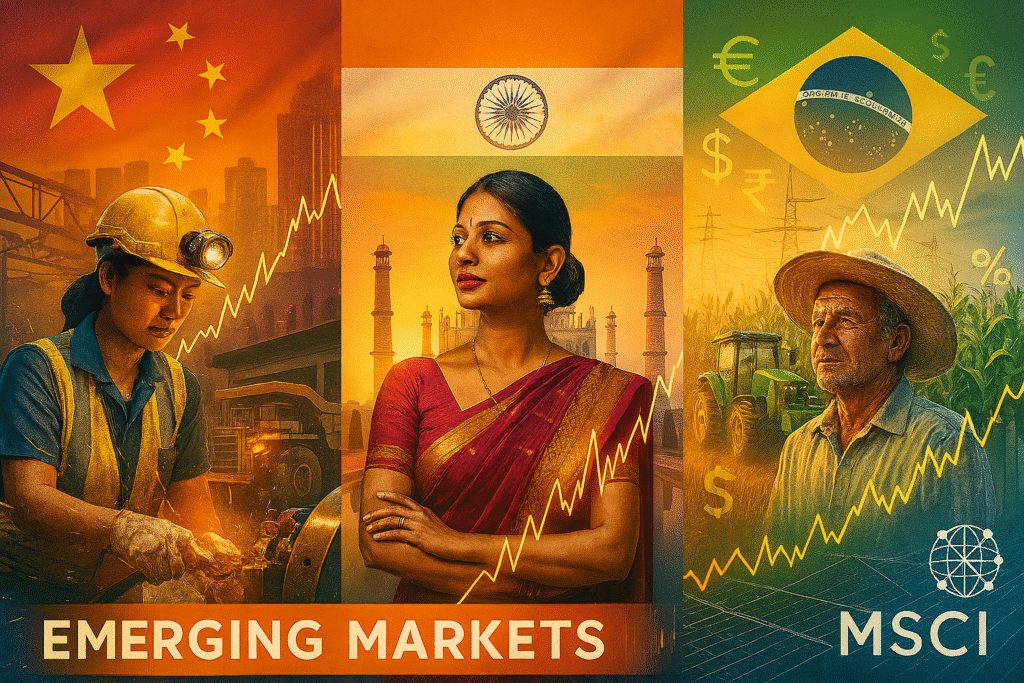The MSCI Emerging Markets (EM) Index is a pivotal benchmark for investors seeking exposure to emerging markets. It offers insights into the dynamic and rapidly evolving economies of countries like China, India, and Brazil. This article explores the drivers of emerging market growth. It examines key challenges such as commodity cycles, inflation pressures, and political risks. It also provides strategies for investors navigating this volatile yet rewarding landscape.

Key Drivers: China, India, and Brazil
Emerging market growth is significantly driven by three major economies:
- China: As the world’s second-largest economy, China has been a cornerstone of global manufacturing and supply chains. Despite challenges like an aging population and environmental issues, China continues to influence global markets. This is through its economic policies and industrial output.
- India: With one of the largest populations and a burgeoning middle class, India presents vast opportunities. This is evident in sectors like information technology and services. However, the country faces challenges such as income inequality and infrastructure constraints. These could impact sustained growth.
- Brazil: As Latin America’s largest economy, Brazil leverages its natural resources and industrial capabilities to drive emerging market growth. The nation’s agricultural exports are significant on the global stage, though issues like political instability and environmental concerns persist.
Commodity Cycles: A Double-Edged Sword
Emerging markets often rely heavily on commodities for economic growth. High commodity prices can boost economies, as seen in Brazil and South Africa. But they also make these nations vulnerable to price fluctuations. For instance, a drop in global oil or agricultural prices can lead to reduced revenue and economic instability.
Inflation Pressures: Navigating Economic Uncertainty
Rapid economic growth in emerging markets often leads to rising demand for goods and services. This can outpace supply and drive inflation. In India, for example, the rapid expansion of the economy has led to increased competition for resources. This contributes to inflationary pressures. Additionally, currency depreciation can exacerbate these issues by increasing the cost of imported goods.
Political Risks: Managing Instability
Political risks are inherent in many emerging markets due to varying levels of governance and social stability. This Political instability can lead to policy changes that affect foreign investment and economic growth. For instance, shifts in government leadership or policy priorities can create uncertainty for investors. This is seen in Brazil where political developments have impacted investor confidence.
Investor Strategies: Balancing Opportunity with Volatility
Investors seeking to capitalize on emerging market growth must adopt strategies that balance potential rewards with inherent risks. This involves conducting thorough research to understand market dynamics. It also involves diversifying investments to mitigate risk and staying informed about political and economic developments.
- Diversification: Spreading investments across different sectors and countries can reduce exposure to specific risks associated with individual markets or industries.
- Thorough Research: Understanding the unique challenges and opportunities in each emerging market is crucial for informed investment decisions.
- Risk Management: Utilizing financial instruments like derivatives can help hedge against volatility and protect investments from adverse market movements.
Conclusion: Emerging Market Growth’s Future
In conclusion, the MSCI EM Index reflects the dynamic nature of emerging markets. These are driven by key economies like China, India, and Brazil. While challenges such as commodity cycles, inflation pressures, and political risks pose significant hurdles, they also offer opportunities for growth and innovation. By adopting balanced investment strategies and staying attuned to market dynamics, investors can navigate the complexities of emerging markets. They can capitalize on their potential.
Emerging market growth remains a critical component of global economic development. It offers diverse opportunities for investors willing to engage with its complexities. As these markets continue to evolve, understanding their unique characteristics will be essential. This understanding is crucial for those seeking to thrive in this volatile yet rewarding landscape.